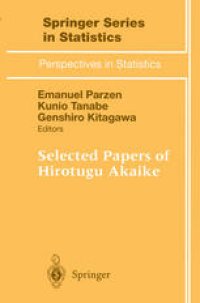
Ebook: Selected Papers of Hirotugu Akaike
- Tags: Statistics for Engineering Physics Computer Science Chemistry and Earth Sciences
- Series: Springer Series in Statistics
- Year: 1998
- Publisher: Springer-Verlag New York
- Edition: 1
- Language: English
- pdf
The pioneering research of Hirotugu Akaike has an international reputation for profoundly affecting how data and time series are analyzed and modelled and is highly regarded by the statistical and technological communities of Japan and the world. His 1974 paper "A new look at the statistical model identification" (IEEE Trans Automatic Control, AC-19, 716-723) is one of the most frequently cited papers in the area of engineering, technology, and applied sciences (according to a 1981 Citation Classic of the Institute of Scientific Information). It introduced the broad scientific community to model identification using the methods of Akaike's criterion AIC. The AIC method is cited and applied in almost every area of physical and social science. The best way to learn about the seminal ideas of pioneering researchers is to read their original papers. This book reprints 29 papers of Akaike's more than 140 papers. This book of papers by Akaike is a tribute to his outstanding career and a service to provide students and researchers with access to Akaike's innovative and influential ideas and applications. To provide a commentary on the career of Akaike, the motivations of his ideas, and his many remarkable honors and prizes, this book reprints "A Conversation with Hirotugu Akaike" by David F. Findley and Emanuel Parzen, published in 1995 in the journal Statistical Science. This survey of Akaike's career provides each of us with a role model for how to have an impact on society by stimulating applied researchers to implement new statistical methods.
The pioneering research of Hirotugu Akaike has an international reputation for profoundly affecting how data and time series are analyzed and modelled and is highly regarded by the statistical and technological communities of Japan and the world. His 1974 paper "A new look at the statistical model identification" is one of the most frequently cited papers in the area of engineering, technology, and applied sciences. It introduced the broad scientific community to model identification using the methods of Akaike's criterion AIC. The AIC method is cited and applied in almost every area of physical and social science. The best way to learn about the seminal ideas of pioneering researchers is to read their original papers. This book reprints 29 papers of Akaike's more than 140 papers. The slected papers are divided into six groups, represent successive phases of Akaike's research interests during his more than 40 years of work at the prestigious Institute of Statistical Mathematical in Tokyo.
The pioneering research of Hirotugu Akaike has an international reputation for profoundly affecting how data and time series are analyzed and modelled and is highly regarded by the statistical and technological communities of Japan and the world. His 1974 paper "A new look at the statistical model identification" is one of the most frequently cited papers in the area of engineering, technology, and applied sciences. It introduced the broad scientific community to model identification using the methods of Akaike's criterion AIC. The AIC method is cited and applied in almost every area of physical and social science. The best way to learn about the seminal ideas of pioneering researchers is to read their original papers. This book reprints 29 papers of Akaike's more than 140 papers. The slected papers are divided into six groups, represent successive phases of Akaike's research interests during his more than 40 years of work at the prestigious Institute of Statistical Mathematical in Tokyo.
Content:
Front Matter....Pages i-viii
Foreword....Pages 1-2
A Conversation with Hirotugu Akaike....Pages 3-16
List of Publications of Hirotugu Akaike....Pages 17-28
On a Zero-One Process and Some of Its Applications....Pages 29-36
On a Successive Transformation of Probability Distribution and Its Application to the Analysis of the Optimum Gradient Method....Pages 37-52
Effect of Timing-Error on the Power Spectrum of Sampled-Data....Pages 53-73
On the Statistical Estimation of Frequency Response Function....Pages 75-79
On the Use of a Linear Model for the Identification of Feedback Systems....Pages 81-114
Fitting Autoregreesive Models for Prediction....Pages 115-129
Statistical Predictor Identification....Pages 131-135
Autoregressive Model Fitting for Control....Pages 137-151
Statistical Approach to Computer Control of Cement Rotary Kilns....Pages 153-170
Statistical Identification for Optimal Control of Supercritical Thermal Power Plants....Pages 171-184
Information Theory and an Extension of the Maximum Likelihood Principle....Pages 185-197
A New Look at the Statistical Model Identification....Pages 199-213
Markovian Representation of Stochastic Processes and Its Application to the Analysis of Autoregressive Moving Average Processes....Pages 215-222
Covariance Matrix Computation of the State Variable of a Stationary Gaussian Process....Pages 223-247
Analysis of Cross Classified Data by AIC....Pages 249-254
On Linear Intensity Models for Mixed Doubly Stochastic Poisson and Self-exciting Point Processes....Pages 255-267
A Bayesian Analysis of the Minimum AIC Procedure....Pages 269-274
A new look at the Bayes procedure....Pages 275-280
On the Likelihood of a Time Series Model....Pages 281-287
Likelihood and the Bayes procedure....Pages 289-307
Seasonal Adjustment by a Bayesian Modeling....Pages 309-332
A Quasi Bayesian Approach to Outlier Detection....Pages 333-345
On the Fallacy of the Likelihood Principle....Pages 347-356
A Bayesian Approach to the Analysis of Earth Tides....Pages 357-360
Factor Analysis and AIC....Pages 361-370
Prediction and Entropy....Pages 371-386
Experiences on the Development of Time Series Models....Pages 387-410
Implications of Informational Point of View on the Development of Statistical Science....Pages 411-420
Back Matter....Pages 421-432
....Pages 433-435